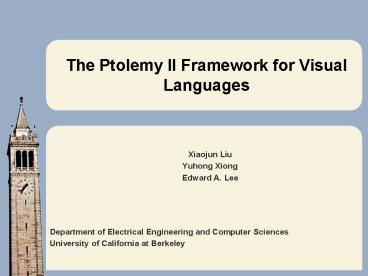The Ptolemy II Framework for Visual Languages - PowerPoint PPT Presentation
1 / 15
Title:
The Ptolemy II Framework for Visual Languages
Description:
The Ptolemy project studies modeling, simulation, and design of concurrent, real ... lang. plot. Kernel. moml. actor. gui. data *charts (Girault, Lee and Lee) ... – PowerPoint PPT presentation
Number of Views:43
Avg rating:3.0/5.0
Title: The Ptolemy II Framework for Visual Languages
1
The Ptolemy II Framework for Visual Languages
- Xiaojun Liu
- Yuhong Xiong
- Edward A. Lee
2
Ptolemy II - Heterogeneous Modeling and Design in
Java
Principal Investigator Edward A. Lee Technical
Staff Christopher Hylands Mary P. Stewart
Postdocs and Researchers Johan Eker Joern
Janneck Winthrop Williams
The Ptolemy project studies modeling, simulation,
and design of concurrent, real-time, embedded
systems. The focus is on assembly of concurrent
components. The key underlying principle in the
project is the use of well-defined models of
computation that govern the interaction between
components.
Grad Students Christopher Chang Elaine
Cheong Chamberlain Fong Jie Liu Xiaojun
Liu Steve Neuendorffer
Brian Vogel Yuhong Xiong Yang Zhao
3
Approach to Visual Modeling
- Abstract syntax clustered graph of entities and
relations. - Executable entities and execution control actors
communicate with each other through message
passing under the control of a director. - Domains implementation of semantics for
component interaction. - charts mixing finite state machine (FSM) with
other domains. - System-level types formal framework to study the
dynamic properties of component interaction.
4
Abstract Syntax
Clustered graphs well-suited to a wide range of
domains, ranging from state machines to process
networks
5
Clustering
Composite entities and ports provide a simple and
powerful, domain-independent abstraction mechanism
The ports deeply connected to the red port are
the blue ones.
6
Executable Entities and Execution Control
Actors communicate with each other through
message passing. Directors control the execution
of actors.
Director
Actor
Actor
IOPort
Tokens
7
Domain Examples
- Continuous Time (CT) actors interact via
continuous-time signals. - Discrete Event (DE) actors communicate via
events placed on a real time line. - Synchronous Dataflow (SDF) actors perform
regular computations on data streams. - Synchronous Reactive (SR) actors interact
through signals whose values are aligned with
global clock ticks.
8
Ptolemy II Infrastructure
SDF domain
CSP domain
DT domain
CT domain
PN domain
moml
actor
lang
data
Kernel
DDE domain
math
gui
GR domain
graph
plot
DE domain
Giotto domain
FSM domain
9
charts (Girault, Lee and Lee)
- Motivated by Statecharts and hybrid systems.
- Allows nesting FSMs with a variety of models of
computation. - Nesting can happen at any level in a
heterogeneous model. - Decouples the concurrency model from the
hierarchical FSM semantics.
10
charts Ptolemy II Implementation
- FSMActor
- Modal Model
11
Example Sticky Masses
The stickiness is exponentially decaying with
respect to time.
12
Sticky Masses Block Diagram
13
Sticky Masses Simulation
Created by Jie Liu, Xiaojun Liu and Yuhong Xiong.
14
Formal Framework for Component Interaction
- Treat different communication protocols in
Ptolemy II domains as types interaction types or
system-level types. - Type signature and component behavior described
by interface automata (de Alfaro and Henzinger). - Compatibility of components with an interaction
type checked through automata composition. - Simulation relation captures subtyping of
interaction types. - Components may be polymorphic compatible with
multiple interaction types.
15
Conclusion
- Visual models in Ptolemy II are built on 3
layers abstract syntax, executable entities,
domains. - Implemented charts formalism nesting FSMs with
a variety of models of computation. - Developed a formal framework to study component
interaction. - For more information
http//ptolemy.eecs.berkeley.edu
Release 1.0.1 available for download































